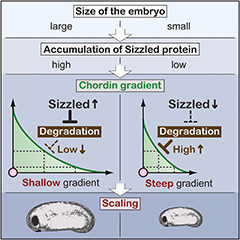
Spemmann's organizer is a signalling center that plays a crucial role in the formation of the dorsal-ventral axis of the embryo. It does so by secreting proteins that diffuse through the embryo instructing it what structure to become, such as the Chordin protein.
New research by Dr Sasai's group at the Center for Developmental Biology shows using the model organism Xenopus laevis, that the robust dorsal-ventral patterning seen in embryos depends on the degradation of Chordin controlled dynamically by Chordin-proteinase activity.
This process requires the expression of the Chordin-proteinase inhibitor Sizzled, which stabilizes Chordin and expands its distribution in the ventral area of the embryo.
The authors demonstrate that Chordin and Sizzled work together in a finely-tuned, axis-wide, self-regulatory loop that controls Chordin's spatiotemporal distribution.
The level of Sizzled in the embryo is linked to the embryo's size, leading to higher Chordin stability in a lager embryo. The authors conclude that this system is responsible for the dynamic adjustment of the axial pattern to the embryo's size, also called scaling.
The study is published in the journal Cell. DOI: 10.1016/j.cell.2013.05.004
